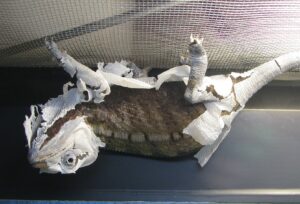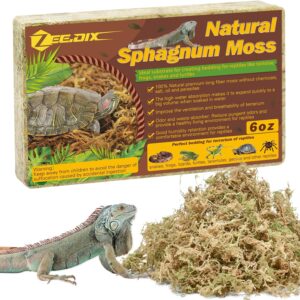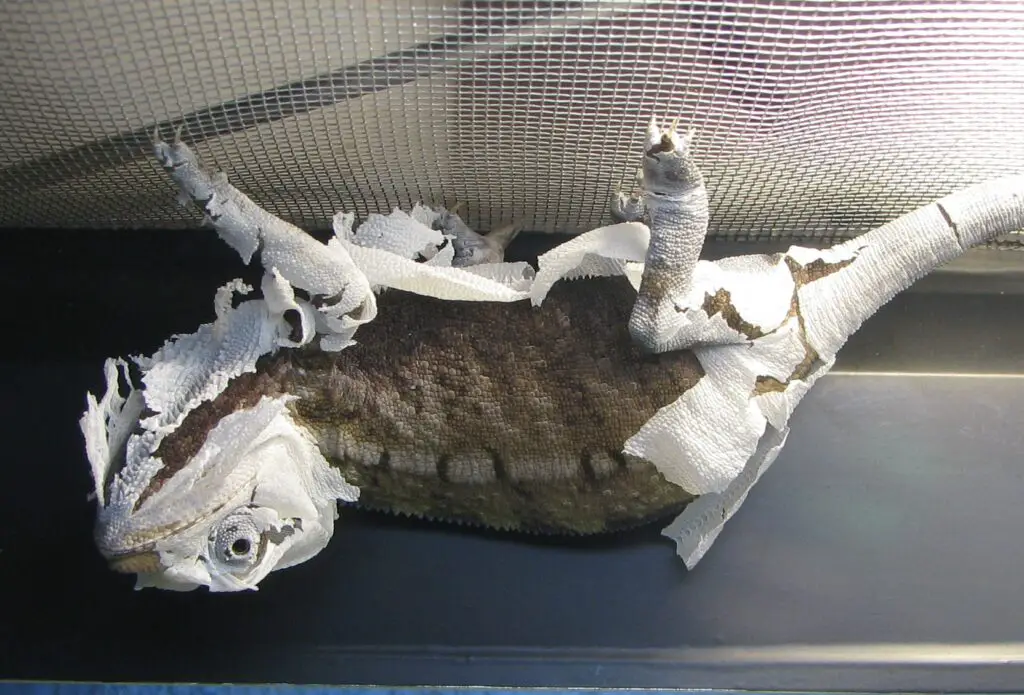Why is my bearded dragon turning white?
Why is my bearded dragon turning white: Bearded dragons, scientifically known as Pogona vitticeps, have quickly become one of the most popular reptile pets around the world. With their docile nature, unique appearance, and relatively low maintenance requirements, they have captured the hearts of reptile enthusiasts and beginners alike.
These fascinating creatures are native to the arid regions of Australia and are known for their distinctive spiky beard and ability to change color. However, one peculiar phenomenon that often leaves owners bewildered is when their bearded dragon starts turning white.
Brief Overview of Bearded Dragons as Popular Reptile Pets
 As mentioned earlier, bearded dragons have gained immense popularity in recent years as household pets. Their gentle demeanor makes them particularly suitable for families with children or those new to reptile keeping.
As mentioned earlier, bearded dragons have gained immense popularity in recent years as household pets. Their gentle demeanor makes them particularly suitable for families with children or those new to reptile keeping.
Originating from the arid central regions of Australia, these reptiles have adapted remarkably well to captivity. Bearded dragons can reach an average length of 18-24 inches (45-60 cm) from head to tail tip when fully grown.
They typically have broad triangular heads with rows of spiky scales running along both sides of their body and a large “beard” under their chin that they can puff out when threatened or displaying dominance. In captivity, bearded dragons require specialized care to replicate their natural environment adequately.
A well-maintained enclosure should include a heat source such as a basking lamp to provide warmth and UVB lighting essential for vitamin D synthesis. The enclosure should also be equipped with climbing structures, hiding spots, and a shallow water dish for drinking and bathing.
Intriguing Statement about Bearded Dragons Turning White
Amidst the joyous experience of caring for a bearded dragon comes occasional confusion when owners spot changes in their pet’s coloration. It is not uncommon for these reptiles to undergo variations in their skin color, including turning pale or even white.
This phenomenon can be alarming to some, but it is essential to understand that such changes are often temporary and can have various underlying causes. In the following sections, we will explore the possible reasons behind these color changes in bearded dragons.
Shedding, stress-induced whitening, and health-related factors will be discussed in detail to shed light on this intriguing aspect of their biology. Understanding these processes will help owners provide better care for their scaly companions and ensure their well-being.
Understanding Bearded Dragon Coloration
Natural Color Variations in Bearded Dragons
 Bearded dragons (Pogona vitticeps) are renowned for their captivating and diverse coloration. These reptiles exhibit a wide range of natural color variations, making each individual unique and visually striking.
Bearded dragons (Pogona vitticeps) are renowned for their captivating and diverse coloration. These reptiles exhibit a wide range of natural color variations, making each individual unique and visually striking.
Common colors seen in bearded dragons include various shades of brown, tan, orange, yellow, and even hints of red or blue. These color variations can depend on factors such as geographic location, subspecies, and individual genetics.
The incredible palette of colors displayed by bearded dragons is not only visually appealing but also serves essential purposes. In their natural habitats across the arid regions of Australia, bearded dragons utilize their distinct color patterns for camouflage and thermoregulation.
The ability to blend with their surroundings helps them avoid predators while hunting for prey or basking under the sun. Furthermore, these colorations play a crucial role in attracting mates during the breeding season.
Role of Genetics in Determining Color Patterns
Genetics plays a significant role in determining the intricate color patterns observed in bearded dragons. The inheritance of specific genes dictates which colors are dominant or recessive in an individual’s genetic makeup. Through selective breeding practices carried out by reputable breeders over many generations, different morphs or variations have been developed with specific traits.
For instance, breeders have selectively bred dragons to enhance desirable traits like intense orange or yellow pigmentation known as “citrus” morphs or to produce individuals with vibrant red scales referred to as “blood” morphs. By understanding the intricacies of genetics involved in bearded dragon coloration, breeders can create unique combinations that cater to the preferences of reptile enthusiasts.
Factors Affecting Temporary Changes in Coloration
While natural colors remain relatively stable throughout a bearded dragon’s life, temporary changes in coloration can occur due to various factors. Environmental conditions, such as temperature and lighting, play a crucial role in influencing the intensity of a bearded dragon’s color.
Higher temperatures can intensify pigmentation while cooler temperatures may cause colors to appear more subdued. Additionally, stress and mood-related changes can also cause temporary alterations in a bearded dragon’s coloration.
When experiencing stress or discomfort, some individuals may exhibit paler or even whitish hues. This response is thought to be an evolutionary adaptation that enables them to blend with bright surroundings when feeling threatened or vulnerable.
It is important for reptile owners to understand the natural color variations in bearded dragons and how genetics, environmental conditions, and stress can influence their appearance. By having this knowledge, enthusiasts can appreciate the beauty of these creatures while also recognizing any abnormal or concerning changes that may signal a need for further investigation or care adjustments.

III: Shedding Process and Color Changes. Why is my bearded dragon turning white?
Explanation of the shedding process in bearded dragons
The shedding process, scientifically known as ecdysis, is a natural phenomenon that occurs in bearded dragons and many other reptiles. It involves the shedding or sloughing off of their old skin to make way for new growth.
As bearded dragons grow, their skin becomes tight and restricts movement. Shedding allows them to replace their old skin with fresher, more pliable layers that accommodate their increasing size.
Importance of shedding for growth and renewal of skin
Shedding plays a crucial role in the growth and renewal of a bearded dragon’s skin. It enables them to replace damaged or worn-out outer layers while providing an opportunity for fresh cells to develop beneath. The process allows the reptile’s skin to maintain its integrity, elasticity, and functionality.
Frequency and duration of shedding cycles
Bearded dragons typically shed their skin multiple times throughout their lifetime. Young dragons shed more frequently than adults due to rapid growth.
On average, juveniles may shed every couple of weeks or monthly while adult bearded dragons shed every one to two months. The duration of each shedding cycle varies but generally lasts around one week or slightly longer.
Relationship between shedding and temporary whitening
During the shedding process, it is common for bearded dragons’ coloration to undergo temporary changes that can include whitening or paling of the skin. The old layer becomes duller as new layers develop below it before eventually sloughing off entirely. This paleness results from air getting trapped between the old and new layers during the transition phase.
Shedding-induced color changes as a normal occurrence
 It is crucial for bearded dragon owners not to be alarmed by shedding-induced color changes, including temporary whitening. This is a natural and normal occurrence in the reptile’s life cycle.
It is crucial for bearded dragon owners not to be alarmed by shedding-induced color changes, including temporary whitening. This is a natural and normal occurrence in the reptile’s life cycle.
The process allows for new, vibrant skin to emerge once the old skin has been fully shed. However, it is important to monitor other factors that may cause persistent paleness or abnormal color changes, as these could indicate underlying health issues.
Health-Related Causes for Whitening
Nutritional deficiencies and malnutrition
Nutrition plays a vital role in maintaining a bearded dragon’s overall health and appearance. If a dragon does not receive an adequately balanced diet, it may experience nutritional deficiencies or malnutrition. This can lead to compromised skin pigmentation, resulting in dullness or paleness of the skin.
1: Impact on overall health and appearance
When a bearded dragon lacks essential nutrients such as calcium, vitamin D3, or proper hydration levels, its overall health can suffer. Nutritional deficiencies weaken the immune system and compromise various bodily functions, thereby affecting the reptile’s physical appearance as well.
2: Specific nutrients essential for vibrant skin pigmentation
To maintain vibrant skin pigmentation, bearded dragons require specific nutrients in their diet. Calcium is crucial for healthy bone development and maintaining strong scales while vitamin D3 aids in calcium absorption. A balanced diet consisting of calcium-rich foods like gut-loaded insects and dark leafy greens helps ensure optimal skin coloration.
a) Importance of balanced diet with calcium-rich foods
A well-rounded diet that includes calcium-rich food sources is vital for maintaining healthy skin pigmentation in bearded dragons. Gut-loading insects with calcium supplement powder before feeding them to your dragon helps provide these essential nutrients.
b) Role of vitamin D3 synthesis in maintaining coloration
Vitamin D3 plays a crucial role in calcium metabolism and absorption. Bearded dragons require adequate exposure to UVB lighting or natural sunlight to synthesize vitamin D3 in their skin. Without sufficient UVB exposure, the reptile may develop deficiencies that could impact its coloration.
Stress-Induced Whitening Phenomenon
stress responses in bearded dragons
Bearded dragons, like all living creatures, can experience stress. Environmental stressors such as sudden loud noises or movements can trigger physiological responses in these reptiles. Additionally, social stressors like aggressive interactions with other animals or inadequate habitat conditions can also induce stress.
1: Environmental stressors (loud noises, sudden movements)
Sudden loud noises or fast movements near a bearded dragon’s enclosure can startle and cause them temporary distress. These stimuli activate the reptile’s natural fight-or-flight response, resulting in various physiological changes that might include temporary whitening as a consequence.
2: Social stressors (aggressive interactions with other animals)
Aggressive interactions with other animals or overcrowded enclosures can lead to social stress in bearded dragons. This type of stress can manifest through changes in behavior and physical appearance, including temporary whitening.
Connection between stress and temporary whitening
When exposed to stressful situations, bearded dragons release cortisol—the primary hormone associated with the “stress response.” Elevated cortisol levels can affect various bodily functions and trigger physiological changes that may include temporary whitening of the skin.
1: Activation of the “stress response” hormone cortisol
The release of cortisol prepares bearded dragons for potential danger by redirecting energy resources towards survival mechanisms. As a result, certain physical processes are temporarily altered, potentially leading to changes in skin coloration.
To sum up why is my bearded dragon turning white
As bearded dragon owners, it’s essential to understand the shedding process, which is a natural part of their growth and renewal. Temporary whitening during shedding is normal and should not cause undue concern.
However, it is crucial to ensure that the reptiles receive proper nutrition to maintain vibrant skin pigmentation and monitor for persistent paleness that may indicate health-related issues. By providing a well-rounded diet and minimizing stress factors, we can keep our bearded dragons healthy and content, allowing their true colors to shine brightly.
Further Reading:
- Carolina Custom Cages Terrarium Review
- 8 Best Basking Rocks for Beardie: What Is the Best Choice?
- 10 Best Thermometers for Beardie: How to Choose the Best One?
- 5 Best Beardie Lighting Setups for Beardie Lovers
- 9 Best Heat Lamps for Beardie: Natural Habitat Provided


